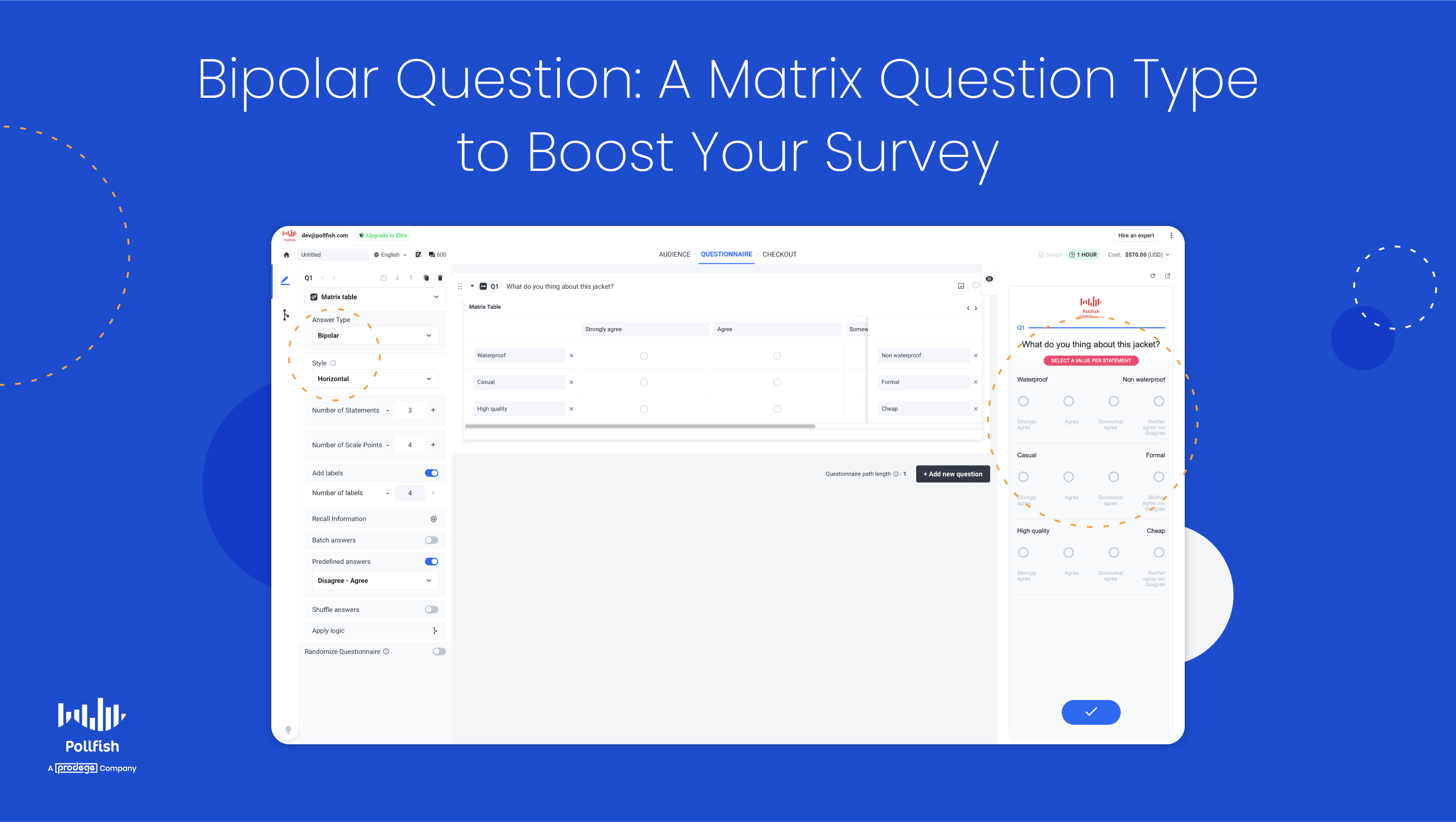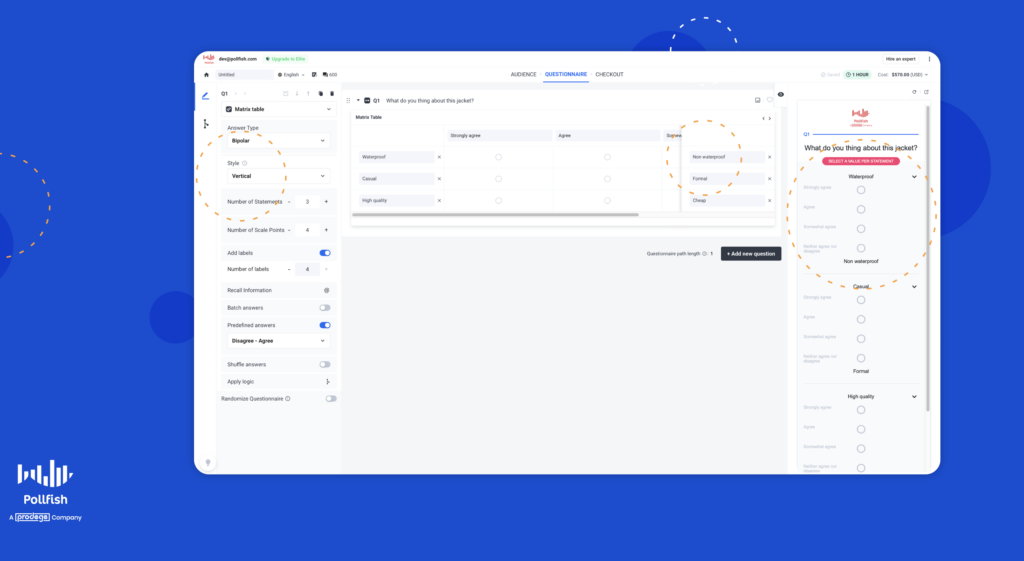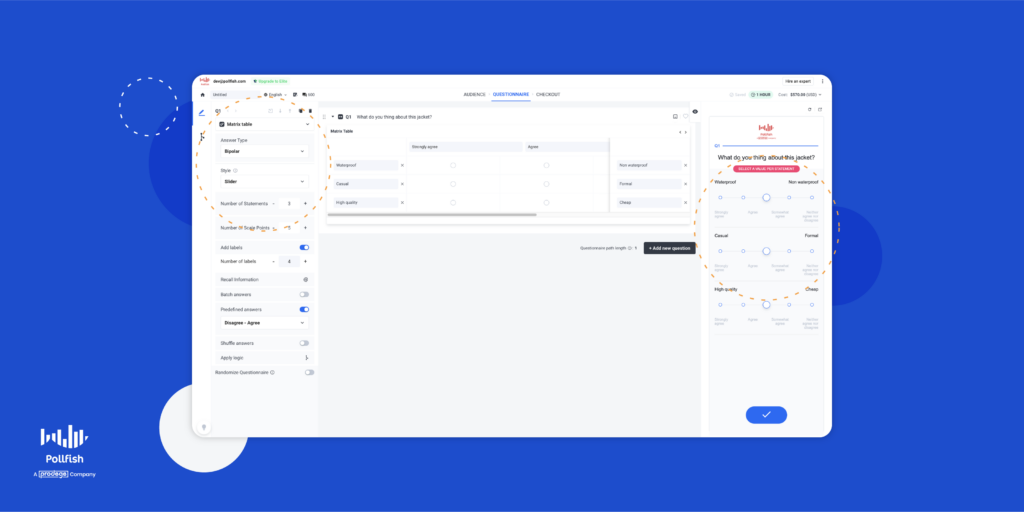The New Bipolar Question: A Matrix Question Type

We’ve recently released a new version of the Matrix question type called the Bipolar Question, which is a specialized variation of this question type. With this new functionality, you can help respondents answer by including dual-labeling, as this variation includes a scale — the Bipolar Scale.
Each end of the Bipolar scale is marked to show its two extremes. This way, respondents will quickly determine which side has the more positive answers and which leans on the negative ones. In addition, they’ll understand how each side of the scale of answer options differs by understanding which extreme it falls under.
A variation of the Matrix question, it too relies on a table or grid when asking about the same set of characteristics for multiple items, just like you would expect with a Matrix question.
However, this version is distinct in that it displays two extremes of a scale that are set by the researcher. This variation is a more advanced version of the Matrix questions you’re used to seeing and the opposite of the Likert Scale Matrix variation.
This article explains the new Bipolar variation of the Matrix question type, its importance, examples, how it differs from the Likert variation and how to use it on the Pollfish platform.
Understanding the Bipolar Question Variation
The Bipolar question is a kind of variation of a Matrix question, which is also called a Matrix table question. As such, you’ll need to have a firm understanding of this main question type before undertaking any of its variations.
What is a Matrix Question?
This question type utilizes a table or grid as a means to present the questions and answer options. It is typically used to ask about the same set of characteristics for multiple items, such as how often a respondent uses a product or service.
The question itself is set up as a table or a grid to bring the information together for the respondent in an easily understandable way.
Matrix table questions allow you to combine a set of questions with the same answer options. This is especially useful when you seek to ask multiple questions that can be rated on the same scale, meaning, they can all be measured with the same answer options that are displayed on a scale. For example, on a scale of extremely rarely to extremely frequently.
The Bipolar Matrix Question Type

As aforesaid, this question type is a variety of the Matrix question. It takes essentially the same layout as a Matrix question and has one defining characteristic: a marked display of two extremes of the table or scale.
Given the emphasis on the two opposites of the scale, this scale is called the Bipolar Scale, granting this variation to its name.
The researcher (or platform user) is in charge of setting the two extreme ends of the scale and making them noticeable. This is done by assigning each end with a name. For example:
in the following question: “How would you rate this sneaker?” the two extremes would be marked by the words: “extremely painful” and “extremely comfortable.”
Each descriptive word would be displayed at the opposite ends of the scale. This shows respondents where each answer option is relative to the two extremes.
How the Bipolar Question Works
Respondents select a point between the two extremes, with the point being an answer option in the scale. These points can also be labeled as a means of further helping guide respondents through the Bipolar Scale. They can have labels that match the type of intensity of the point.
For example, they can be labeled as “very little” to “none at all.” Other options include using the same labels on each side of the scale, with a single point for neither or neutral, such as “very little” and “very much” or “highly unlikely” and “highly likely” on each side.
The Importance of the Bipolar Question Variation
This Matrix question variation is important for several reasons.
First off, it is useful to include in your survey if you seek to measure consumer preferences and opinions based on intensity. It is especially important if you want to measure your respondents’ views on something regarding your brand based on two opposite extremes.
This is crucial, as many times, shopping habits, sentiments and customer behavior can all be whittled down into two main categories, or fall somewhere in between two main categories. These often exist as two opposites that you can study your customers with, based on what they choose in between or at the polar ends of the two extremes.
Secondly, this question type is important, as it helps guide your respondents on how to answer the question, based on how each option is oriented. As such, they’ll better understand which extreme their answer is associated with.
They’ll also understand how neutral their answers are, or whether they slightly gravitate towards one end or the other. By helping your respondents better understand under which extreme their answer lies, you’ll also reap more accurate responses, which will provide you with key data for decision-making.
Lastly, this kind of question variation creates a more visual and engaging survey experience. Due to its helpful nature in helping your respondents choose an answer, it makes a more lively and enjoyable survey experience.
Not only will this speed up the survey process, which will bring you faster insights, but it will also improve your brand reputation if you include your brand name or specific product or service in the question itself, or somewhere else in the survey.
All in all, the Bipolar question variation is critical for various reasons concerning survey user experience, providing more accurate answers, getting speed to insights and improving your overall brand experience.
The Bipolar Question Type on Pollfish
You can set up the Biopolar Scale to your liking by choosing how you label the two extreme ends and the points on the scale.
The following displays how this new question type looks on the Pollfish platform:

How the Bipolar Question Type Differs from the Likert Question Type
Both of these question types are variations of the Matrix question. As such, the Matrix question type exists as the parent question category, while Bipolar and Likert Scale variations are the more granular child categories.
Both categories therefore can use a scale of 5-7 questions and both use a Matrix table, but their distinct version of it.
Let’s explore how they differ from each other in the following table:
| Bipolar Scale Matrix Question | Likert Scale Matrix Question | |
| What’s displayed | Two extremes of a scale in a table format. | A list of statements as rows and scale points as columns in a table format. |
| Question options | Respondents select a point between the two extremes. | A single answer, a multiple answer, a drop-down list, or a drag and drop. |
| Answer Labeling | Because the two extremes are marked, labeling individual points is optional. | Each option always has a label. |
| Answer Options | Respondents can provide just one answer. | Respondents can provide more than one answer. |
How to Use the Bipolar Matrix Question Variation on Pollfish
Creating this question type and using it on the Pollfish market research platform is easy to do. First, go to the questionnaire section of your survey. Then, select your question type in the lefthand panel.
Then choose from the following options to set up your Bipolar Scale:
- There are 2 extreme-scale values for each statement.
- Select the length of the scale points and add the number of labels, as you will have to choose how to represent the Bipolar question to your respondents.
- Use rows and columns( horizontal and vertical cells or use the Sliders.
Afterward, choose from the available settings for your Bipolar Matrix question:
- The number of statements, AKA, rows has no restriction.
- Scale points, the radio buttons available also have a few restrictions and conditions:
- Include up to 20 for Horizontal and Vertical cells.
- Use up to 11 for the slider.
- Use up to 20 statements for all forms.
- Labels, which are optional and go above the scale points. They do not have to be the same number as the scale points.
Don’t forget to type in your question and have your answer options (the points) you seek to fill in.
Next, consider how we implement this question type:
- In the questionnaire
- Using advanced skip logic
- On mobile and desktop versions
- On the results page
- In exports, BQ and file exports
- With Survey Translations
Finally, review your question and answer options (the points) and add more Bipolar or other questions to your questionnaire.
Curious about how to build your ideal survey? You can learn how to make your own survey in just three easy steps on the Pollfish online survey platform.
Setting Up the Ideal Matrix Table
You can now use the Pollfish platform to create a specialized Matrix question: the Bipolar question type. A variation of the Matrix question, it helps you create a more custom question format that guides respondents on which extreme their answer falls under.
Giving you the chance to fish out more accurate answers while creating a more engaging survey experience, using this question variation is a must. That’s why it is equally important to select a strong online survey platform that facilitates creating this question type.
But there’s more when it comes to choosing the right online survey platform. You should choose a survey provider that enables you to survey anyone. As such, you’ll need a platform with a reach to millions of consumers, along with one that offers the Distribution Link feature.
The former method works via Random Device Engagement, which targets and gathers respondents where they voluntarily are across different digital channels. Thus, it distributes surveys randomly, across a wide network of digital properties. This includes websites, mobile sites and mobile apps, making for a randomized survey deployment.
The latter method, which uses the Distribution Link feature empowers you to send your survey to specific customers, instead of only deploying them across a large network. This enables you to target respondents you know are your customers via email and social media as well as adding your link across digital channels, such as landing pages, homepages, etc.
It is also important to use a mobile-first platform, as mobile dominates the digital space and no one wants to take surveys in a shoddy mobile environment.
The online survey platform you opt for should also offer artificial intelligence and machine learning to remove low-quality data, offer a broad range of survey and question types and disqualify low-quality data.
With an online survey platform that offers all of these capabilities, you’ll be able to form your ideal survey and easily set up and use the Bipolar Scale question variation.
Pollfish Marketing Team
Ready to Try Pollfish?
Create your survey with AI, target high-quality respondents starting at $0.95 per complete, and start getting results in just minutes in real-time. From running a simple product concept survey to managing a constant stream of trackers for dozens of clients in dozens of countries, we’ve got you.
